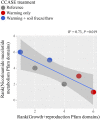Soil Microbes Trade-Off Biogeochemical Cycling for Stress Tolerance Traits in Response to Year-Round Climate Change
- PMID: 32477275
- PMCID: PMC7238748
- DOI: 10.3389/fmicb.2020.00616
Soil Microbes Trade-Off Biogeochemical Cycling for Stress Tolerance Traits in Response to Year-Round Climate Change
Abstract
Winter air temperatures are rising faster than summer air temperatures in high-latitude forests, increasing the frequency of soil freeze/thaw events in winter. To determine how climate warming and soil freeze/thaw cycles affect soil microbial communities and the ecosystem processes they drive, we leveraged the Climate Change across Seasons Experiment (CCASE) at the Hubbard Brook Experimental Forest in the northeastern United States, where replicate field plots receive one of three climate treatments: warming (+5°C above ambient in the growing season), warming in the growing season + winter freeze/thaw cycles (+5°C above ambient +4 freeze/thaw cycles during winter), and no treatment. Soil samples were taken from plots at six time points throughout the growing season and subjected to amplicon (rDNA) and metagenome sequencing. We found that soil fungal and bacterial community composition were affected by changes in soil temperature, where the taxonomic composition of microbial communities shifted more with the combination of growing-season warming and increased frequency of soil freeze/thaw cycles in winter than with warming alone. Warming increased the relative abundance of brown rot fungi and plant pathogens but decreased that of arbuscular mycorrhizal fungi, all of which recovered under combined growing-season warming and soil freeze/thaw cycles in winter. The abundance of animal parasites increased significantly under combined warming and freeze/thaw cycles. We also found that warming and soil freeze/thaw cycles suppressed bacterial taxa with the genetic potential for carbon (i.e., cellulose) decomposition and soil nitrogen cycling, such as N fixation and the final steps of denitrification. These new soil communities had higher genetic capacity for stress tolerance and lower genetic capacity to grow or reproduce, relative to the communities exposed to warming in the growing season alone. Our observations suggest that initial suppression of biogeochemical cycling with year-round climate change may be linked to the emergence of taxa that trade-off growth for stress tolerance traits.
Keywords: climate change; forest ecology; microbial communities; soil freezing; warming; winter.
Copyright © 2020 Garcia, Templer, Sorensen, Sanders-DeMott, Groffman and Bhatnagar.
Figures





Similar articles
-
Growing-season warming and winter soil freeze/thaw cycles increase transpiration in a northern hardwood forest.Ecology. 2020 Nov;101(11):e03173. doi: 10.1002/ecy.3173. Epub 2020 Sep 22. Ecology. 2020. PMID: 32852804
-
Declining winter snowpack offsets carbon storage enhancement from growing season warming in northern temperate forest ecosystems.Proc Natl Acad Sci U S A. 2025 Jul 15;122(28):e2412873122. doi: 10.1073/pnas.2412873122. Epub 2025 Jul 7. Proc Natl Acad Sci U S A. 2025. PMID: 40623184
-
Subarctic winter warming promotes soil microbial resilience to freeze-thaw cycles and enhances the microbial carbon use efficiency.Glob Chang Biol. 2024 Jan;30(1):e17040. doi: 10.1111/gcb.17040. Glob Chang Biol. 2024. PMID: 38273522
-
Effects of Freeze-Thaw Cycles on Uptake Preferences of Plants for Nutrient: A Review.Plants (Basel). 2025 Apr 4;14(7):1122. doi: 10.3390/plants14071122. Plants (Basel). 2025. PMID: 40219190 Free PMC article. Review.
-
Forest Soil Bacteria: Diversity, Involvement in Ecosystem Processes, and Response to Global Change.Microbiol Mol Biol Rev. 2017 Apr 12;81(2):e00063-16. doi: 10.1128/MMBR.00063-16. Print 2017 Jun. Microbiol Mol Biol Rev. 2017. PMID: 28404790 Free PMC article. Review.
Cited by
-
Exploring Trait Trade-Offs for Fungal Decomposers in a Southern California Grassland.Front Microbiol. 2021 Apr 20;12:655987. doi: 10.3389/fmicb.2021.655987. eCollection 2021. Front Microbiol. 2021. PMID: 33995318 Free PMC article.
-
Seasonal Variations in Fungal Communities on the Surfaces of Lan Na Sandstone Sculptures and Their Biodeterioration Capacities.J Fungi (Basel). 2023 Aug 8;9(8):833. doi: 10.3390/jof9080833. J Fungi (Basel). 2023. PMID: 37623604 Free PMC article.
-
Long-term climate establishes functional legacies by altering microbial traits.ISME J. 2025 Jan 2;19(1):wraf005. doi: 10.1093/ismejo/wraf005. ISME J. 2025. PMID: 39804671 Free PMC article.
-
Trait-trait relationships and tradeoffs vary with genome size in prokaryotes.Front Microbiol. 2022 Oct 21;13:985216. doi: 10.3389/fmicb.2022.985216. eCollection 2022. Front Microbiol. 2022. PMID: 36338105 Free PMC article.
-
Patterns in soil microbial diversity across Europe.Nat Commun. 2023 Jun 8;14(1):3311. doi: 10.1038/s41467-023-37937-4. Nat Commun. 2023. PMID: 37291086 Free PMC article.
References
-
- Aanderud Z. T., Jones S. E., Schoolmaster D. R., Fierer N., Lennon J. T. (2013). Sensitivity of soil respiration and microbial communities to altered snowfall. Soil Biol. Biochem. 57 217–227. 10.1016/j.soilbio.2012.07.022 - DOI
-
- A’Bear A. D., Boddy L., Jones T. H. (2012). Impacts of elevated temperature on the growth and functioning of decomposer fungi are influenced by grazing collembola. Glob. Chang. Biol. 18 1823–1832. 10.1111/j.1365-2486.2012.02637.x - DOI
-
- A’Bear A. D., Jones T. H., Boddy L. (2014a). Potential impacts of climate change on interactions among saprotrophic cord-forming fungal mycelia and grazing soil invertebrates. Fungal Ecol. 10 34–43. 10.1016/j.funeco.2013.01.009 - DOI
-
- A’Bear A. D., Jones T. H., Kandeler E., Boddy L. (2014b). Interactive effects of temperature and soil moisture on fungal-mediated wood decomposition and extracellular enzyme activity. Soil Biol. Biochem. 70 151–158. 10.1016/j.soilbio.2013.12.017 - DOI
-
- Addy H., Miller M., Peterson R. (1997). Infectivity of the propagules associated with extraradical mycelia of two AM fungi following winter freezing. New Phytol. 135 745–753. 10.1046/j.1469-8137.1997.00707.x - DOI

